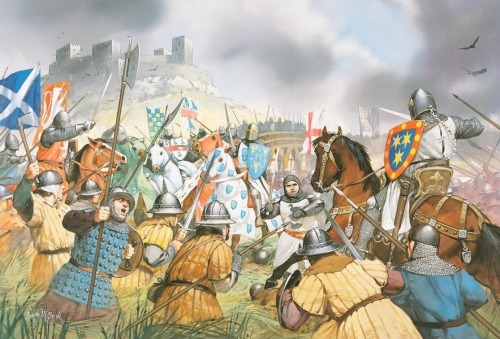Robert the Bruce Part IV — King Robert’s War,In case you missed: Part I, Part II, Part I
Robert the Bruce Part IV — King Robert’s War,In case you missed: Part I, Part II, Part III In the winter of 1307-1308, it seemed that the Scottish bid for independence was at an end as Robert the Bruce fell deathly ill. Many thought that the Bruce would surely die, as he suffered a terrible bout of fever, followed by a period of seizures, followed by a period of near catatonia. If the Bruce should die without an heir, then all hope of restoring the Scottish monarchy would die with him.Then, as if by a miracle, the Bruce recovered from his illness in the spring of 1308. With the new spring, the Bruce began again his strategy of lighting fast hit and run warfare across Scotland, raiding English castles and garrisons all over the country. In a typical Bruce attack, Scottish forces would strike quickly and effectively, using superior terrain and the element of surprise to their advantage. When they stormed fortresses and castles, they burned and destroyed them rather than occupying them. Robert the Bruce’s tactics relied upon speed, castles only slowed him down, he didn’t need them. After destroying the enemy garrison, the Scots would then quickly flee, leaving nothing but scorched earth and destruction in their wake. Because of his destructive raids and lighting quick movements, Robert the Bruce would become known as one of the greatest guerrilla fighters in history. One of his greatest victories was in Aberdeen in June of 1308. After a quick campaign where he destroyed a handful of castles belonging to the supporters of John Comyn (Scots who opposed the Bruce’s rule), he marched across the country and conducted a surprise attack on the English held fortress at Aberdeen. Taking a page from English King Edward II, who ordered the immediate execution of all rebellious Scots, the Bruce ordered the English garrison to be mercilessly slaughtered to the man. Aberdeen castle’s stonework buildings were knocked to the ground, and her woodwork burnt to ashes. Then the Scots left as quickly as they had arrived.For eight years the Bruce conducted his guerrilla campaign against the English, destroying every English castle and fort in the country, and executing every English soldier and knight who got in his way. Robert the Bruce’s terrible raids, quick strikes, and unwillingness to fight on even ground gave him a reputation as a barbaric and ruthless barbarian among the English. In many parts of England, the Bruce became a boogeyman figure who terrorized children at night. While the Bruce was ruthless in the treatment of the English, it was the Scots themselves who received the worst of his wrath. Some Scottish clans did not support the Bruce as King, most of whom were supporters of other claimants to the throne, such as John Comyn (whom the Bruce had murdered during a conference), and the former king John Balliol. In order to cement his rule, the Bruce not only had to conquer the English, he had to conquer the Scots as well.Robert the Bruce not only set out to defeat the supporters of John Comyn, he set out to completely annihilate the Comyn line. After defeating the Comyn forces at the Battle of Barra in 1308, the Bruce carried out a campaign of terror and extermination now known as the “harrying of the north”. All male members of Clan Comyn and their supporters were put to the sword. Those who survived did so by escaping to exile in England, the most noted of which was John Comyn III, son of the murdered John Comyn. The Bruce then ordered all farms to be burnt, all livestock slaughtered, and all crops destroyed. When the Bruce was finished, the lands of Clan Comyn were reduced to rot and ashes. The Comyn’s would never pose a problem for the Bruce again.After the “harrying of the north”, Bruce ordered similar campaigns against clan MacDougall in the territories of Argyll and Kintyre. While the Bruce’s actions were bloody, murderous, and ruthless, the Bruce had succeeded in uniting Scotland in one single cause; the creation of a free and independent Scottish kingdom. By 1309 he controlled almost all of Northern Scotland. It was in March of the same year that the Bruce held his first Parliament in St. Andrews, the first in 150 years. Although the Parliament lasted only two days, they produced a document called the “Declaration of the Clergy” (pictured above), which announced that Scotland could only be ruled with the consent of the Scottish people. King Edward II of England did not have the support of the people, however Robert the Bruce ruled as King of Scotland with their whole-hearted consent. Ideas such as the notion of the “consent of the governed” was revolutionary for the time, but only represented the nobility and church leadership. The average Scot had little say over his life and destiny. Regardless, the Declaration of the Clergy is regarded as a treasured national document in Scotland, much like the Declaration of Independence in America.By 1309 and 1310, the Bruce was capturing English held garrisons in Southern Scotland, and by 1311, Scottish forces were even conducting raids in Northern England and English occupied Ireland. Despite his successes, the English were far from total defeat, and they still held his wife and daughter prisoner, preventing the Bruce from producing a heir. The Bruce’s health was also deteriorating, as he suffered relapses of the mysterious illness that plagued him in 1307 and 1308. The Bruce needed a large, major, decisive victory to cement his throne, and he needed it quickly.To Be Continued… -- source link
#history#scottish history#scotland#guerrilla warfare#war#battle#monarchy#monarchs

